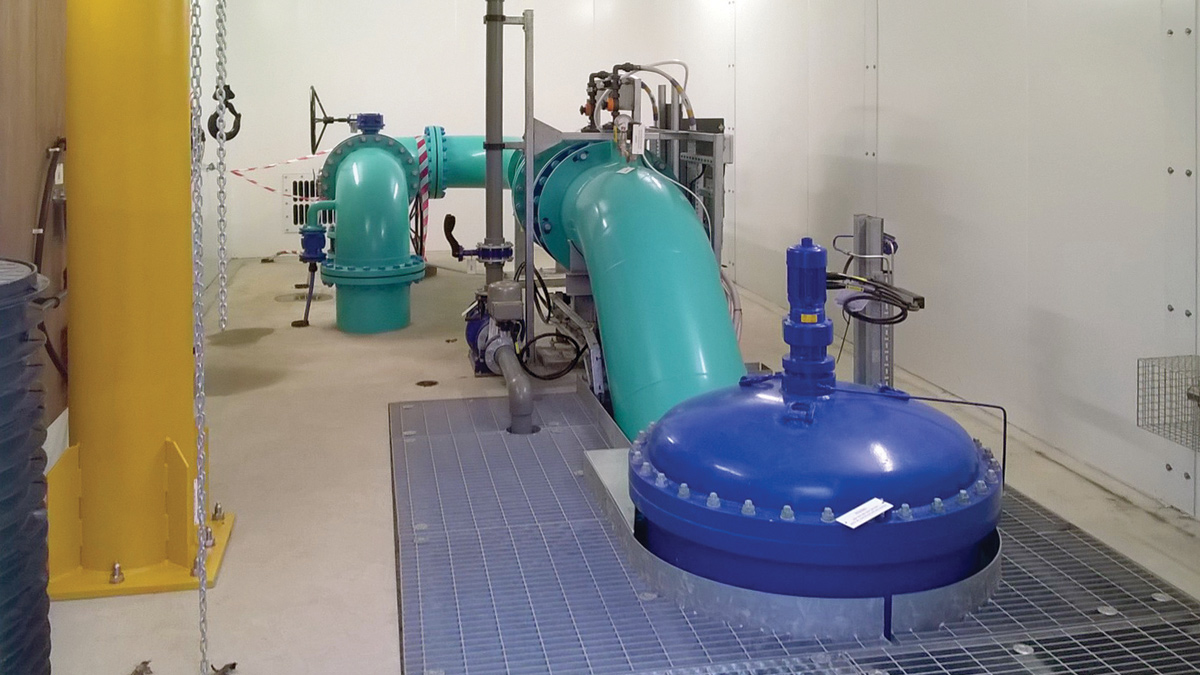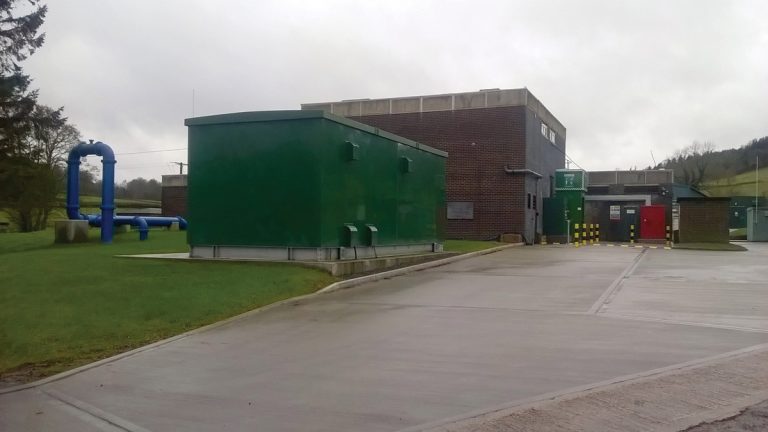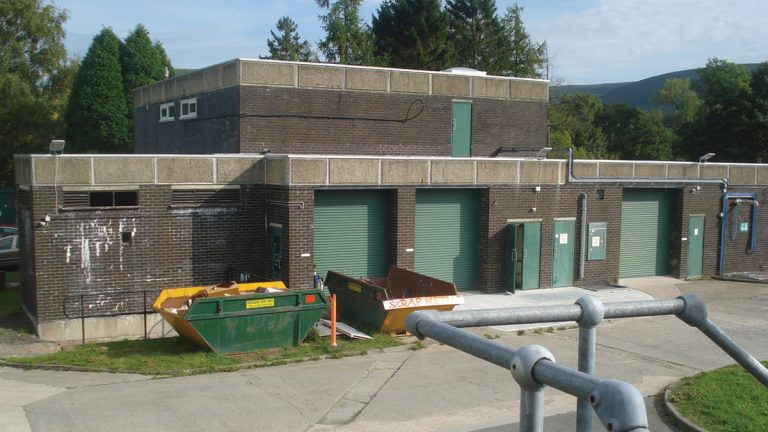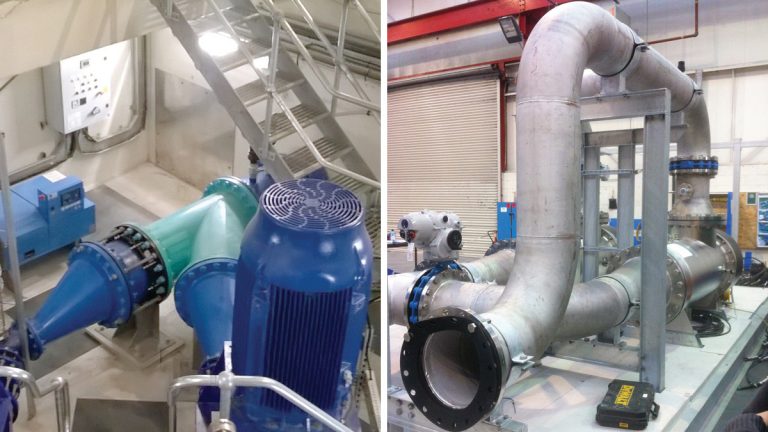Llandinam Resilience Scheme (2016)

New filtration building and sump - Courtesy of Mott MacDonald Bentley Ltd
The £2.9m Llandinam Resilience Scheme required the design and construction of a 20,000m3/day treatment plant which can be brought online reliably within 6 hours of detecting a significant failure of the existing treatment stream. The successful completion of the scheme by design and build contractor Mott MacDonald Bentley (MMB) on behalf of Severn Trent Water, has resulted in a more resilient water supply for 52,000 customers in mid-Wales, which contributes to ensuring that the water supply in mid-Wales is ‘Always On and Good to Drink’. The Llandinam Resilience Scheme is an outstanding example of what can be achieved when a client and a design and build partner work collaboratively with a clear goal, embrace innovation and have a holistic approach to delivering the right solution and best value for customers.
Introduction
The solution embraces the design for manufacture and assembly (DfMA) philosophy with the ability to innovatively integrate the result into previously abandoned assets.
The new resilience plant operates independently from the existing treatment stream and comprises:
- An automatic backwashing filtration plant.
- A caustic soda plant to correct the pH.
- A mobile UV unit to kill bacteria.
- A sodium hypochlorite dosing plant to chlorinate the water.
- A reinforced concrete high lift tank and pumping station to pump water to Llandinam Service Reservoir.

Mobile UV treatment – Courtesy of Mott MacDonald Bentley Ltd
Background
Llandinam Water Treatment Works (WTW) is the sole source of water for approximately 52,000 customers in mid-Wales. The works supply a large area via a complex network including more than 40 (No.) service reservoirs and 42 (No.) booster pump stations.
The key driver for the scheme and the principal benefit for the community was to provide water supply resilience. The scheme is part of the long term resilience strategy for the Llandinam Control Group which considers the water source, the treatment stream and the distribution network separately. This scheme focused on treatment resilience and was included in the PR09 Severn Trent Business Plan with an OFWAT regulatory output date of March 2015.
From the outset, there was a significant affordability challenge in addition to delivering the scheme described in the Business Plan. There was also the need to provide additional pH correction to ensure that the resilience stream could deliver water that is good to drink. The initial project estimate of £4m was well above the business plan allowance of £2.9m, making the scheme unaffordable.
The project team was challenged to deliver the enhanced outcome for no more than the original business plan allowance.
The team worked collaboratively to find innovative approaches to scope definition, design, construction, commissioning and risk management. After an extensive review of plant failure scenarios and detailed risk and value challenge workshops, over £1m of savings were identified bringing the scheme below the affordability line and allowing the project to proceed. A Target Price of £2.54m was agreed with an all-inclusive project cost of £2.9m.

WTW to be refurbished – Courtesy of Mott MacDonald Bentley Ltd
Risk and value challenge
During the early design stage a holistic review of the control group was carried out followed by a comprehensive risk assessment of all single, key points of failure within the treatment works to ensure that the resilience capital intervention was tailored to the need. Efforts were also made to prioritise works which brought added benefit to the normal operation of the plant.
As a result of this approach the team was able to:
- Implement a new re-zoning plan to maximise the available ‘response to failure’ time by closing strategic valves on the network.
- Remove the need to dual the mains between the boreholes and the treatment works saving approximately £300k. The risk was understood through detailed discussions with front line burst responders and reduced by supplying strategic spares for storage at Llandinam to ensure repairs could be implemented before the reservoir reached critical levels.
- Provide new assets which improve the operability of the existing treatment works e.g. a new Boll filter plant serving the normal and resilience streams providing a significant operational saving.
- Provide duty – only equipment on the resilience stream reducing cost and complexity.
- Provide a mobile UV plant as the main resilience process treatment for killing bacteria which can be moved and deployed to other sites in emergencies. This was the first mobile UV unit built for Severn Trent.
Sustainable development
As civil engineers it is crucial to conserve resource and promote sustainable development. The team embodied this ethos where the approach was to eliminate any single point of failure in a sustainable manner, firstly by operational procedure, then by reuse or optimisation of existing assets and, as a last resort, new resilience assets.
A number of 1950s assets were abandoned in the 1990s when the current membrane plant was built to protect the water supply from risks posed by bacteria in the raw water. The abandoned assets presented a great opportunity for the project team to reuse and refurbish. Through careful design, detailed inspection and condition assessment, the team was able to reuse the lime plant building, the pump station and contact tank as well as numerous lengths of ductile iron pipework. They were modified to provide a caustic dosing room, a hypochlorite dosing facility, a 100m3 pump suction tank and a below ground pump station capable of pumping 20,000m3/day.
Reusing the abandoned contact tank and refurbishing the treatment building reduced cost and yielded an embodied carbon saving of more than 50%. There were also added benefits for the local community in terms of a reduction in the number of construction related HGV movements and a reduced visual impact. Refurbishing the abandoned lime dosing room to enable the installation of a bespoke caustic tank removed the need for potentially unsightly external bulk storage tanks which is a great result for local residents.
Llandinam WTW is situated on the edge of the River Severn flood plain surrounded by numerous environmental constraints including active badger sets, bats and the adjacent river bed site of special scientific interest. Reusing existing assets minimised the impact on the local environment.

(left) Basement pump station and (right) factory built UV plant – Courtesy of Mott MacDonald Bentley Ltd
Efficient design & build – production control and factory thinking
One of the key priorities for the project was to meet the OFWAT regulatory date of 31 March 2015. The tight construction programme of 10 months meant that collaborative work between MMB, Severn Trent, and key suppliers was critical.
The scheme used a collaborative planning approach to build accountability and ensure that no interfaces were overlooked. A ‘plan to protect’ philosophy was adopted to build programme resilience. Both of these methods proved hugely beneficial enabling the scheme to be delivered in time for the OFWAT deadline and some two months shorter than the average AMP5 programme for a scheme of similar size. As a result of positive feedback collaborative planning is now implemented throughout Severn Trent.
The resilience plant was designed and built using a modular style which allowed work to commence on several areas at a time, maximising the efficiency and shortening the construction programme. Where practical, elements were factory built and delivered to site.
MMB and Severn Trent realise that health and safety performance is imperative and health and safety leadership comes from all levels in the company. The Llandinam site had a proactive health and safety culture which was demonstrated by a high level of positive intervention reporting. The efforts to prefabricate and to re-furbish all contributed to reducing the risk involved with the build.
Previous experience had shown that the activity most likely to delay completion was connecting to the existing network. Llandinam required five large scale pipework connections, all of which involved total works shut downs. In order to protect the programme these works were sequenced as early as possible. The connections involved a high level of risk which required extensive contingency planning. Each intervention was planned down to five minute intervals and executed successfully, within the four hour window allowed, resulting in no loss of supply.
Conclusion
A well designed resilience plant is robust and easy to operate in an emergency. The Llandinam scheme is designed to have a permanent sweetening flow and an automated switching system which allows the plant to start up within 15 minutes. This significantly outperforms the original requirement and is a great result.
Ensuring operators are able to use the plant competently in an emergency was imperative to the success of the project. To achieve this, the team came up with an innovative approach, providing the operators with a step by step illustrated operation manual and a YouTube style video which can be viewed on a smart phone.
The team also ensured that as part of operational procedure the resilience plant is run for six hours every month to ensure that all operators are familiar with the plant. Having the resilience plant available to operations has simplified the maintenance tasks on the existing membrane and added efficiency as larger sections of the plant can be taken off line for planned maintenance and optimisation activity.
The success of this project was recognised in June 2015 when the water produced by the resilience plant was awarded best Severn Trent water supply as part of a competition between all Severn Trent water treatment works.





